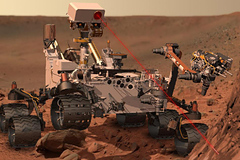Canada has designed a powerful ground-based laser that accelerates spaceships to Mars
Scientists at McGill University in Canada have proposed a project for a new laser-thermal engine that will reduce the travel time of a spacecraft to Mars to 45 days compared to six months of flight for ships with chemical engines. The concept, described in the journal Acta Astronautica, suggests that an array of lasers installed on Earth will heat hydrogen plasma in a chamber at the rear of an interplanetary spacecraft and create thrust from hydrogen gas emissions. Briefly about the project is described in a press release on Phys.org .
According to the engineers' idea, a phased array of infrared lasers with a total diameter of ten meters and a power of 100 megawatts can deliver a directed beam to a spacecraft located in lunar space. The beam will be focused in the heating chamber using an inflatable reflector, which is located in an elliptical near-Earth orbit. The hydrogen fuel heated to 10 thousand kelvin is ejected through the nozzle, which will allow the ship to reach a specific impulse of 3000 seconds (the same time the engine will work on one kilogram of fuel, creating a thrust of one newton). For comparison, the specific impulse of liquid rocket engines reaches only about 470 seconds.
It is expected that the laser-accelerated payload weighing one ton will fly superfast, at a speed of 17 kilometers per second relative to the Earth. Naturally, this speed will remain when reaching Mars, so braking and entering orbit around the Red Planet will be a difficult engineering task. If chemical fuel is used on board to decelerate the rocket, this will reduce the payload mass to less than six percent of the original ton. Therefore, dynamic braking in the Martian atmosphere will be the only way to slow down the flight of the payload until a second laser array is built on the planet.
Such braking will be a risky maneuver, as a result of which the payload may be lost due to extreme loads and friction against the atmosphere. However, the authors of the project note that new heat-protective materials are being developed that can withstand extreme heat.
One of the advantages of a laser-thermal installation is not only a high specific impulse, but also a low mass-to-power ratio (0.001-0.010 kilograms per kilowatt), which is much lower than that of nuclear engines, due to the fact that the energy source remains on Earth. A large focal length for energy transmission of 50 thousand kilometers is provided by micron-sized fiber-optic lasers with amplifiers with a power of 100 watts each. The amplifiers are a loop of optical fiber and an LED and can be produced en masse, and for a Mars mission they will need about one million.

